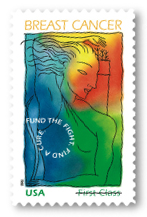 |

Breast Cancer Stamp Will Fund Premalignancy Research
NCI's Executive Committee (EC) recently approved a comprehensive program in breast cancer premalignancy research that includes the areas of prevention, etiology, biology, diagnosis, and molecular epidemiology. Funding for this unique program will come from the highly successful Stamp Out Breast Cancer Act, enacted in 1997, under which the U.S. Postal Service created and sells a special-issue stamp with a surcharge above the first-class postage rate to support breast cancer research.
 The distribution of funds from the sale of the Breast Cancer Stamp is set at 70 percent to NIH and 30 percent to the Department of Defense. As of November 2005, NCI had collected more than $33.5 million and has awarded (in obligations plus commitments) more than $25.4 million in grants and contracts, through Insight Awards and an RPG Exceptions Program.
The distribution of funds from the sale of the Breast Cancer Stamp is set at 70 percent to NIH and 30 percent to the Department of Defense. As of November 2005, NCI had collected more than $33.5 million and has awarded (in obligations plus commitments) more than $25.4 million in grants and contracts, through Insight Awards and an RPG Exceptions Program.
Last fall, during the EC's discussions on how to spend the stamp money in 2006, NCI Deputy Director and Deputy Director for Translational and Clinical Sciences Dr. John Niederhuber strongly urged that it be used to address multiple aspects of breast cancer around a unifying theme, and include intramural components and extramural divisions and centers. "I view it as another opportunity to create a collaborative and integrated scientific program across NCI divisions and centers and, by working together, fill research gaps and synergistically reach new discoveries and interventions," he explained.
At the recent inaugural meeting of a transdisciplinary NCI steering committee for the Breast Cancer Premalignancy Program, a wide-ranging, integrated research plan that encompasses the following elements from all NCI research divisions and centers was presented:
- Molecular epidemiology and biology of mammographic density (Division of Cancer Epidemiology and Genetics)
- Evaluation of different decision-making approaches to chemoprevention (Division of Cancer Prevention)
- Evaluation of strategies for early detection of breast cancer (Division of Cancer Control and Population Sciences, with matching funds from the American Cancer Society)
- Biology of breast premalignancy (Division of Cancer Biology)
- Isolation, propagation, characterization, and imaging of tumor stem cells (Center for Cancer Research)
- MRI-guided therapy with targeted SPIO carbon nanostructures (Division of Cancer Treatment and Diagnosis).
The Breast Cancer Premalignancy Program is similar to the Special Programs of Research Excellence (SPORE) within NCI and NIH, Dr. Niederhuber observed, and involves work on breast cancer stem cells, pathways, the microenvironment, molecular target identification (biomarkers), imaging, drug discovery, and translation.
"I have no doubt that the Breast Cancer Premalignancy Program will lead to real advances in understanding and preempting the biological changes that lead to this terrible disease," he added. "That knowledge gives me a special sense of gratification every time I receive a letter with one of the 'Fund the Fight and Find a Cure' stamps."
|